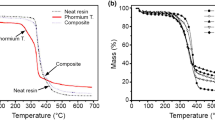Abstract
Non-isothermal curing kinetics of a tetra functional epoxy resin with imidazole-based curing agents was investigated by differential scanning calorimetry (DSC), and decomposition of the cured compounds was studied by thermogravimetric analysis. N,N,N′,N′-tetraglycidyl-4, 4′diaminodiphenylmethane (TGDDM) was cured with three types of tertiary amine curing agents including 1-methyl imidazole (MI), 2-methyl imidazole (2MI) and 2-ethyl 4-methyl imidazole (EMI). These systems exhibited cure initiation at around 70–90 °C by DSC. 2-methyl imidazole and 2-ethyl 4-methyl imidazole showed two cure initiation profiles, while the 1-substituted counterpart, MI, showed a single cure initiation profile by DSC. The Kissinger equation was applied to calculate the apparent activation energy for epoxy–imidazole cure reactions. The rate constants and the pre-exponential factor were also determined. The activation energy varied from 59 to 65 kJ mol−1 for the systems. The Flynn–Wall–Ozawa iso-conversional approach was used to elucidate the activation energies at different extents of conversion during the cure reactions. The cured systems are found thermally stable up to 250 °C. Decomposition kinetics of cured networks was studied using Kissinger equation and Flynn–Wall–Ozawa iso-conversional approach. The cured resins were analyzed for the glass transition temperature and compared with that of a conventional amine-cured system.









Similar content being viewed by others
References
Jin FL, Li X, Park SJ. Synthesis and application of epoxy resins: a review. J Ind Eng Chem. 2015;29:1–11.
Weil ED, Levchik S. A review of current flame retardant systems for epoxy resins. J Fire Sci. 2004;22:25–40.
Sprenjer S. Epoxy resin composites with surface-modified silicon dioxide nanoparticles: a review. J Appl Polym Sci. 2013;130(3):1421–8.
Rafique I, Kausar A, Anwar Z, Muhammad B. Exploration of epoxy resins, hardening systems, and epoxy/carbon nanotube composite designed for high performance materials: a review. Polym Plast Technol. 2016;55(3):312–33.
Mustata F, Bicu I. Multifunctional epoxy resins: synthesis and characterization. J Appl Polym Sci. 2000;77(11):2430–6.
May CA. Epoxy resins, chemistry and technology. New York: Marcel Dekker; 1988.
Cheng J, Li J, Zhang JY. Curing behavior and thermal properties of trifunctional epoxy resin cured by 4, 4′-diaminodiphenyl sulfone. Expr Polym Lett. 2009;3(8):501–9.
Qiu SL, Wang CS, Wang YT, Liu CG, Chen XY, Xie HF, Huang YA, Cheng RS. Effects of graphene oxides on the cure behaviors of a tetrafunctional epoxy resin. Expr Polym Lett. 2011;5(9):809–18.
Yu M, Feng B, Xie W, Fang L, Li H, Liu L, Ren M, Zhnag J, Sun J, Hu H. The modification of a tetrafunctional epoxy and its curing reaction. Materials. 2015;8(6):3671–84.
Unnikrishnan KP. Doctoral Dissertation, Cochin University of Science and Technology, India 2006.
Prolongo SG, Prolongo G. Epoxy/poly (4-vinylphenol) blends crosslinked by imidazole initiation. J Therm Anal Calorim. 2007;87(1):259–68.
Potter WG. Epoxide resins. New York: Springer; 1970.
Kissinger HE. Reaction kinetics in differential thermal analysis. Anal Chem. 1957;29:1702–6.
Flynn J, Wall L. A quick, direct method for the determination of activation energy from thermogravimetric data. J Polym Sci Polym Lett. 1966;4(5):323–8.
Barton JM, Shepherd PM. The curing reaction of an epoxide resin with 2-ethyl-4-methylimidazole, a calorimetric study of the kinetics of formation of epoxide-imidazole adducts. Makromol Chem. 1975;176:919–30.
Vogt J. Thermoset matrices for structural adhesives: imidazole-catalysed curing of epoxy resins. J Adhesion. 1987;22:139–51.
Dearlove TJ. A comparison of some imidazole catalysts as epoxy curing agents. J Appl Polym Sci. 1970;14:1615–26.
Yang BK, Gu M. Fabrication. Morphology and cure behavior of triethylenetetramine-grafted multiwalled carbon nanotube/epoxy nanocomposites. Polym J. 2009;41(9):752–63.
Acknowledgements
The authors thank Director, Vikram Sarabhai Space Centre and Deputy Director, VSSC (PCM) for their permission to publish this work.
Author information
Authors and Affiliations
Corresponding author
Rights and permissions
About this article
Cite this article
Leena, K., Soumyamol, P.B., Baby, M. et al. Non-isothermal cure and decomposition kinetics of epoxy–imidazole systems. J Therm Anal Calorim 130, 1053–1061 (2017). https://doi.org/10.1007/s10973-017-6410-5
Received:
Accepted:
Published:
Issue Date:
DOI: https://doi.org/10.1007/s10973-017-6410-5




